As global temperatures rise, Earth observations show that glaciers are retreating and ice sheets are melting everywhere from Greenland to Antarctica while regions of the Arctic are getting greener. Plus, collaborations lead to new Mars and exoplanet discoveries, several rockets launched, and this week’s What’s Up involves Dr. Brian May of Queen.
Podcast
Show Notes
Mars collaboration observes patchy aurorae
- NASA press release
- “Patchy Proton Aurora at Mars: A Global View of Solar Wind Precipitation Across the Martian Dayside From EMM/EMUS,” Michael S. Chaffin et al., 2022 August 31, Geophysical Research Letters
Potentially habitable super-Earth found
- University of Birmingham press release
- University of Liège press release
- “Two temperate super-Earths transiting a nearby late-type M dwarf,” L. Delrez et al., to be published in Astronomy & Astrophysics (preprint)
‘Diamond rain’ experiments involve plastic and lasers
- SLAC press release
- “Diamond formation kinetics in shock-compressed C─H─O samples recorded by small-angle x-ray scattering and x-ray diffraction,” Zhiyu He et al., 2022 September 2, Science Advances
Rockets, week of 9/5/22
- China launches new test satellites via Kuaizhou-1A carrier rocket (Xinhua)
- Eutelsat press release
- Launch video
- NASA press release
Glacier melt exceeds all scientific expectations: research was too optimistic
- For first time on record, Greenland saw extensive melting in September (The Washington Post)
- Hokkaido University press release
- “Glacier mass change on the Kamchatka Peninsula, Russia, from 2000 to 2016,” Shungo Fukumoto et al., 2022 July 4, Journal of Glaciology
- The greening of the Arctic tundra (National Geographic)
- Warming Temperatures are Driving Arctic Greening (NASA)
- These Trees Are Spreading North in Alaska. That’s Not Good (Wired)
- “Sufficient conditions for rapid range expansion of a boreal conifer,” Roman J. Dial, Colin T. Maher, Rebecca E. Hewitt and Patrick F. Sullivan, 2022 August 10, Nature
- University of South Florida press release
- “Rapid retreat of Thwaites Glacier in the pre-satellite era,” Alastair G. C. Graham et al., 2022 September 5, Nature Geoscience
JWST catches a spider: The Tarantula Nebula in the Large Magellanic Cloud
- NASA image release
What’s Up: The Moon, ice giants, and more!
- This Week’s Sky at a Glance, September 2 – 10 (Sky & Telescope)
- Why Uranus and Neptune Are Different Colors (NASA)
NASA updates and improves visualization tool
- NASA JPL press release
Transcript
I have to admit that as an undergrad, I started university thinking I’d go into science policy, and right now, more than ever before, I’m glad I didn’t. For two brief years, I wanted to be one of those folks traveling the world and negotiating space treaties and international collaborations. I switched to pure science when I realized I really didn’t enjoy understanding economics, and learning more about economics was not something I wanted to do. Astronomy and space science, it seemed, would be a less fraught profession.
This week’s science is testing that premise, but given everything going on with Russian rockets, engines, and the ISS, I’m still glad I chose science.
In today’s news, we’re going to ignore those science policy issues and look at climate change… and test my resolve on feeling science is more pleasing to understand. This not entirely pleasing science is bracketed between rocket launches, cool planetary news, and this week’s What’s Up. So we end on a high note?
All of this and more, right here on the Daily Space.
I am your host Dr. Pamela Gay.
And we’re here to put science in your brain.

Much teamwork and collaboration go into making Daily Space, from writing to producing to hosting to editing and publishing. As science communicators, we also collaborate with other people, like Fraser Cain from Universe Today and all the folks we interview or have on as guests. That spirit of collaboration is important to the research endeavors of the science community, coming together as a large group of people on one project… and sometimes as nations sharing mission data.
Two missions orbiting Mars – NASA’s MAVEN and the United Arab Emirates’ Emirates Mars Mission – have recently shared data that led to the detection of patchy proton aurora at Mars. Previously discovered by MAVEN back in 2018, these proton aurorae occur when charged particles from the solar wind interact with Mars’ upper atmosphere. MAVEN and ESA’s Mars Express observed these aurorae as “smooth and evenly distributed”; however, these new observations found patchy versions of the aurora, likely caused by turbulent conditions in the atmosphere.
The results of the analysis were published in the journal Geophysical Research Letters with lead author Mike Chaffin, who explains: EMM’s observations suggested that the aurora was so widespread and disorganized that the plasma environment around Mars must have been truly disturbed, to the point that the solar wind was directly impacting the upper atmosphere wherever we observed auroral emission. By combining EMM auroral observations with MAVEN measurements of the auroral plasma environment, we can confirm this hypothesis and determine that what we were seeing was essentially a map of where the solar wind was raining down onto the planet.
Teamwork makes the dream work, and these multi-vantage-point measurements help scientists put data into a wider context, revealing new phenomena and their mechanisms.
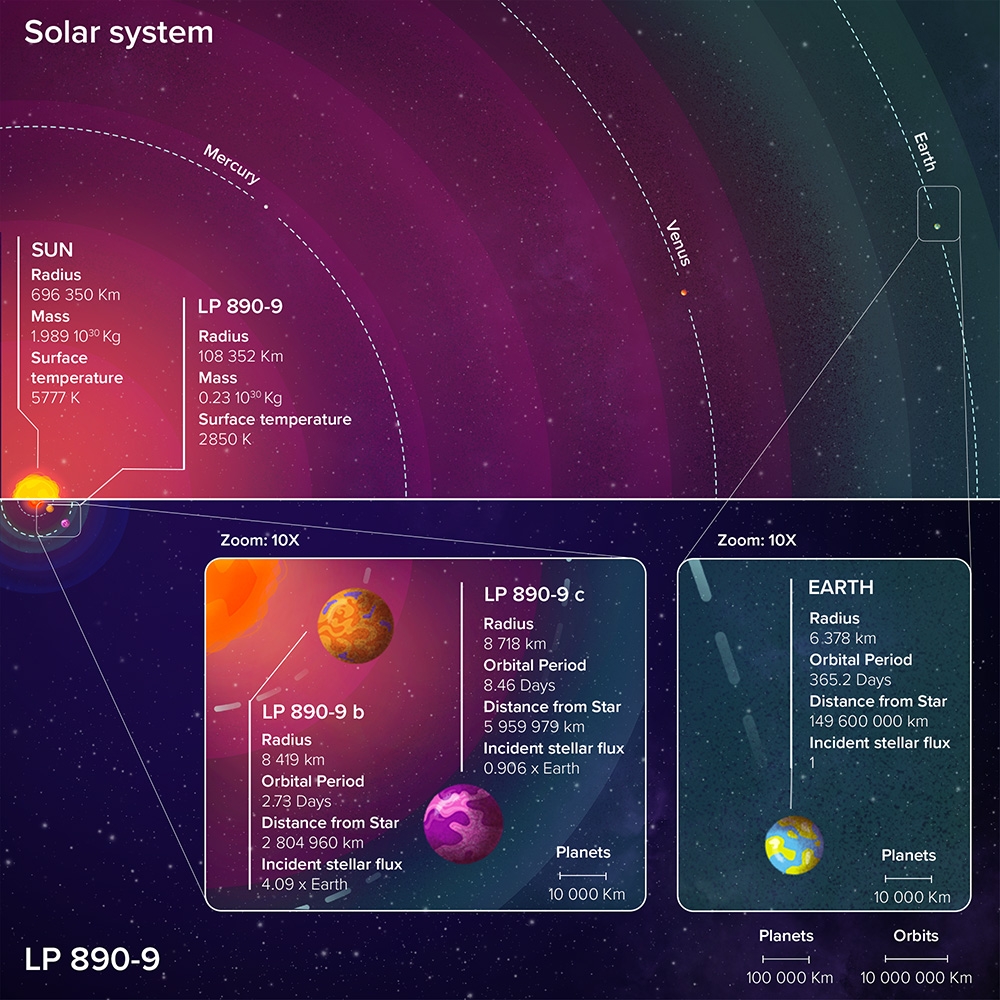
Again, collaborations are important, and an international team of scientists recently announced the discovery of two new exoplanets, one of which is a potentially habitable super-Earth. The parent star is LP 890-0, which is also cataloged as TESS Object of Interest 4306 and SPECULOOS-2, and this star is a very cold red dwarf. In fact, it’s the second coolest star we’ve found planets orbiting, after the famous TRAPPIST-1 system.
The first planet was discovered in data collected by the TESS space telescope, and it’s the closer of the two planets, orbiting in just 2.7 days. It’s also about 1.3 times the size of Earth. And here is where making data accessible becomes important. Using the SPECULOOS telescopes here on Earth, researchers were able to confirm this planet and pin down some of its characteristics. And they were able to detect that second planet, which didn’t appear in the TESS data.
The second planet is about 1.4 times the size of Earth and orbits in 8.5 days – blistering fast by our solar system’s standards. However, that particular orbit also puts the planet in the star’s potentially habitable zone where liquid water could exist on the surface of the rocky world.
And that gives us another great candidate for observations with JWST to characterize the planet’s atmosphere, second only to several of the TRAPPIST-1 planets.
This research was published in Astronomy & Astrophysics with lead author Laetitia Delrez.
And just to wrap up the planetary news with something fun, a new study published in Science Advances with lead author Zhiyu He explains how experiments involving Polyethylene terephthalate (PET) plastic – a common polyester family plastic – show that ‘diamond rain’ could be far more common on exoplanets than thought. The plastic used contains a mixture of carbon, hydrogen, and oxygen that provides a decent approximation of the composition of icy planets like Neptune and Uranus.
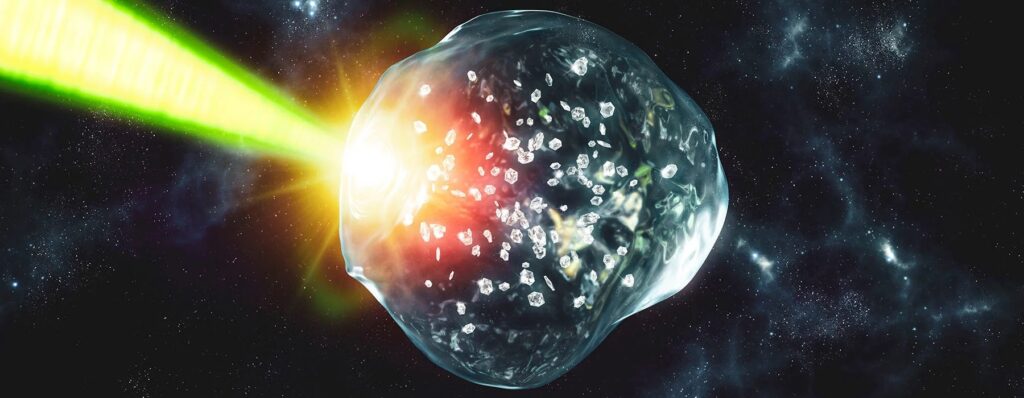
Add in a high-powered optical laser, create shock waves in the PET, and then examine with X-ray diffraction, and the team found nanodiamonds. They also found that this method, which differed from an earlier experiment, allowed them to measure just how fast those diamonds grew. It turns out that the oxygen content made all the difference, as co-author Dominik Kraus explains: The effect of the oxygen was to accelerate the splitting of the carbon and hydrogen and thus encourage the formation of nanodiamonds. It meant the carbon atoms could combine more easily and form diamonds.
Diamond rain likely happens at Neptune and Uranus, and the diamonds there will be much larger than the nanodiamonds created in the lab. So make sure your ice giant umbrella can handle the weather.
And now, let’s change it up with some rockets.
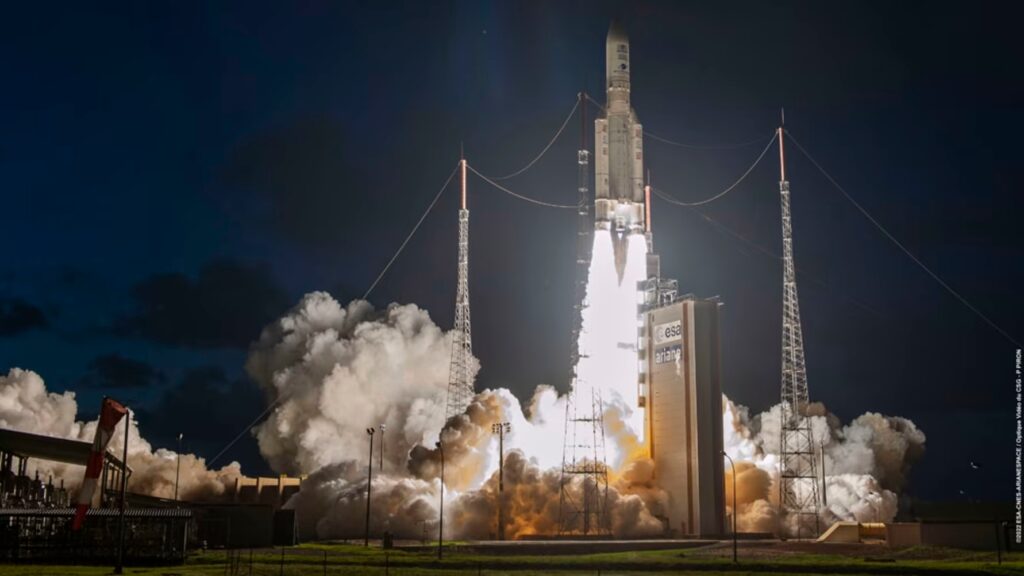
Only a couple of rockets have launched since we last presented. Two of them were from China, a Kuaizhou 1A and Long March 2D, launching payloads we don’t know much about. Both launches were successful.
The third launch this week was an Ariane 5 carrying the Eutelsat Konnect VHTS satellite into Geostationary Transfer Orbit. Eutelsat VHTS, or Very High Throughput Satellite, is a huge 6.4 metric ton communication satellite, so it was launched solo on the Ariane 5. The Ariane 5 usually launches a medium and a small satellite together.
Once in orbit, VHTS will have a Ka-band capability of 500 gigabits per second of Ka bandwidth for fixed broadband and in-flight internet. That’s fast enough to download the entire contents of my computer – one terabyte – in sixteen seconds. Ka, or Kurz-above, is a standard frequency for satellite communications. Starlink and That Telescope, among others, use Ka-band for downlink.
This bandwidth is enabled by the most powerful digital processor ever launched, according to manufacturer Thales Alenia Space. The satellite has an expected lifetime of 15 years, but most last much longer.
The Ariane 5 rocket is nearing its retirement, with only a handful of payloads left to launch including the European Space Agency‘s Jupiter Icy Moons Explorer, or JUICE, launching next year. It will explore Ganymede, Callisto, and Europa from 2029 to 2035. NASA’s Europa Clipper will join it a year later, in 2030, to explore just Europa.

NASA’s DART mission, which will impact the moon of asteroid Didymos in two weeks on September 26, has caught its first glimpse of the asteroid right on schedule. Or it did back on July 27 of this year and announced now in September.
This image is a composite of 243 images taken by the Didymos Reconnaissance and Asteroid Camera for Optical navigation, DRACO. At the time, DART was 20 million miles from the asteroid. DART depends on DRACO to ensure it hits Dimorphos, the moon of Didymos, through several thruster burns up to two minutes before impact. Dimorphos is also called Didymoon unofficially.
I don’t know about all of you, but here in southern Illinois, this past summer was like nothing I’ve previously experienced. To be fair, I’ve only lived in Illinois for sixteen years, but from talking to folks whose families built our 200-year-old town, this area doesn’t even have family stories of “back in my day, we had this one summer that was so hot…”
Well, this summer was so hot that gardeners didn’t have to worry about their baby garden planets getting caught in a late freeze; they had to worry about their seedlings getting caught in an early scorching heat. I have to admit, when temperatures reached into the 90s Fahrenheit in May, I forfeited planting my normal shade crops of beans and lettuce and let the hardier weeds own the yard. I’m going to regret this choice in a couple of weeks when I prep the gardens for winter, but summer has been so far out of the norm that kitchen gardens that would normally have been planted and forgotten required regular watering and extra care.
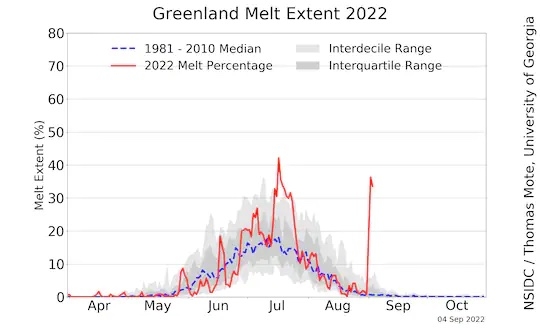
What I experienced here in the great plains was echoed in a variety of ways all around our planet as rivers in the European Union ran dry, and heat soared across the world. As we ended our last season, we brought you stories of Greenland experiencing rain instead of snow for the first time in some places, and now, we’re here to bring you news of a spike in glacial melt occurring in Greenland that has never been seen – let alone seen in September – ever before.
The Washington Post reported on September 6 that over the Labor Day weekend Greenland lost about 20 billion tons of ice. That is 7% of what Greenland loses in a normal year, and that is water heading into the North Atlantic Ocean where it will contribute to sea level rise and lower the salinity of the ocean, which changes ocean circulation patterns.
The rise caused by those 20 billion tons won’t be measurable. It takes thirteen times that much melt to raise the sea by just one millimeter, but Greenland is just one place where we are seeing massive glacier melt. More than one-third of Pakistan has been under water under the one-two punch of massive rains and accelerated glacier melt.
In Russia’s Northern Kamchatka Peninsula, the 405 glaciers lost 4.9 billion tons of ice from 2000 to 2016 due to temperature increases. While this region can normally expect to receive 1.2 meters of snow a year, a weather phenomenon called the Pacific Decadal Oscillation is expected to reduce snowfall and accelerate this melt. This work is published in a new paper in the Journal of Glaciology and was led by Shungo Fukumoto.

This is your reminder that it takes time to do research and get results through the review process and published. This paper reflects conditions six years ago… and things are only accelerating.
The Arctic and Antarctic regions are the fastest-changing in the world. Some of this change is now visible out airplane windows and on Google Maps. The Arctic tundra is greening, and land that has been frozen for centuries is now both revealing millennia-old flora and fauna and allowing the growth of plants normally seen only in warmer climates. These places are developing warmer climates, so I should probably say they are growing plants normally only seen in lower latitudes.
This greening is problematic in a number of ways. The green plants absorb more sunlight than snow or ice, which reflect sunlight away. This absorbed heat is reradiated over time and is actually leading to white spruce trees growing in new and more northern parts of Alaska. Forests not only absorb heat, but they also prevent as much snow from building up and cooling the ground. Our world, one plant at a time, is fundamentally changing.

And it’s not just in the northern hemisphere. The Thwaites Glacier in West Antarctica – about the size of Florida – is also melting at rapid rates. It can raise the ocean by ten feet or just over three meters. In a new study in Nature Geoscience, researchers find that while this glacier actually existed during the otherwise warm Cretaceous period, it is now undergoing rapid retreat. Satellites haven’t caught all the change, and in studies that looked at the ocean floor, researchers led by Alastair Graham found the glacier is retreating 2.1 kilometers a year, which is twice the expected rate.
So, ah… yeah. It’s all melting, and people around the world rely on glacier melt as a major source of fresh water. This means that not only do we need to worry about oceans rising, ocean salinity changing, and flood damage… we also have droughts to look forward to when those glaciers are gone.
Palate cleanser anyone? Here is JWST‘s new image of the Tarantula nebula. We look forward to research results in the future.

What’s Up
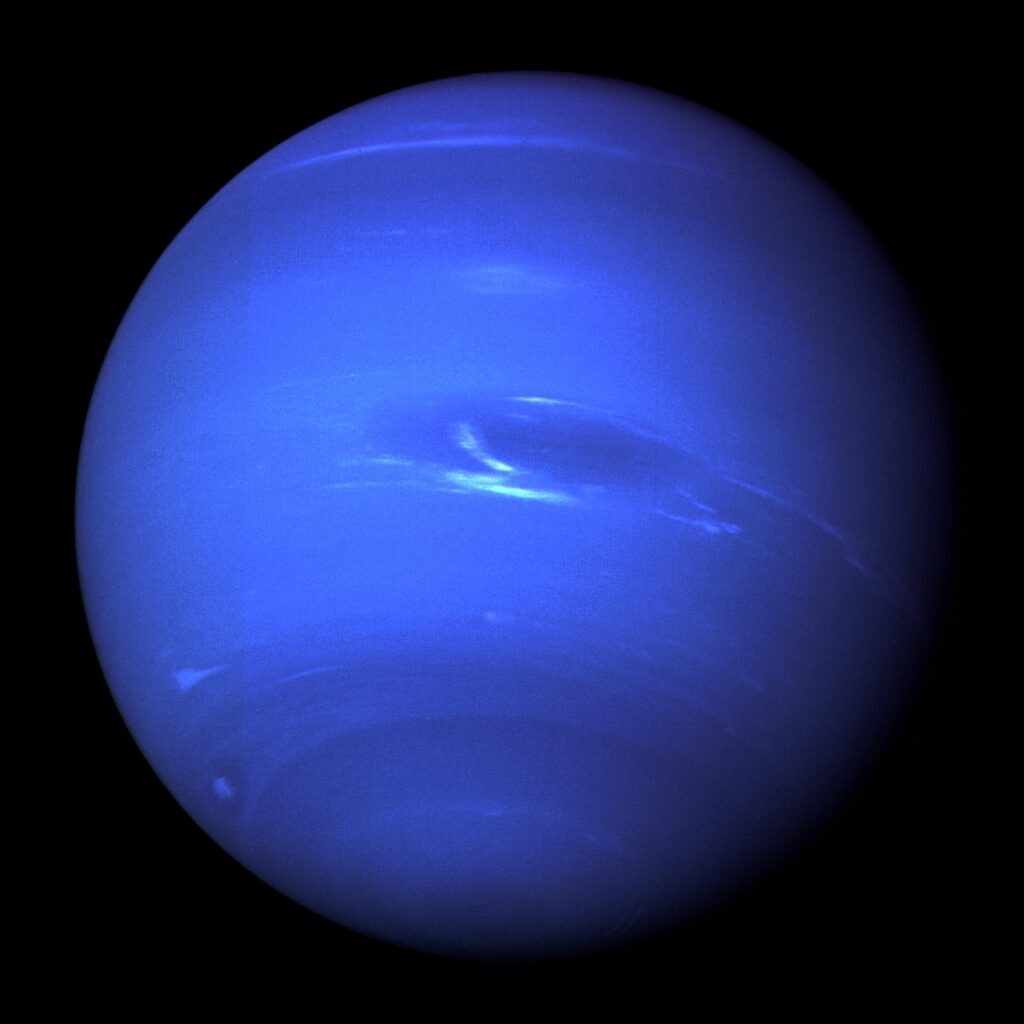
This week in What’s Up is a grab bag of events you can look forward to for the month of September. Next week we’ll have a review of Lightyear on Disney+, so there’s that for you to look forward to. But for now, our solar system and what you can see in it. This week is all about the Moon, ice giants, and Dr. Brian May?
First up, Neptune — specifically that it will be at opposition on September 16. Opposition is when the Earth is directly between Neptune and the Sun, so it will be its brightest and spend the most time above the horizon. Now Neptune is small and relatively dark so it will be difficult to resolve unless you have a larger telescope, say five inches or more.
The next event you should be observing is a close conjunction between Jupiter and the Moon. On September 11, Jupiter will pass within two degrees of the Moon — 1.8 to be precise. As we always say, these close conjunctions are excellent times to see these two bodies right next to each other, either for high-power observation of both at the same time or for interesting wide-field astrophotography compositions. I’ll have reviews of some interesting ultra-wide angle lenses for my Canon camera later this season, so stay tuned for those.
The next event in September is another close conjunction between a planet and the Moon on September 14. The Moon will get remarkably close to Uranus — close enough that if you were anywhere else but the Americas, it would completely cover the planet. This is properly called an occultation. That angular separation, from the U.S., is eight-tenths of a degree. Uranus is the other ice giant in our solar system.
An ice giant is a gas planet like Jupiter or Saturn but made mostly from elements heavier than hydrogen and helium. Those elements got to the planet in the form of ice, hence the name. Neptune and Uranus have hydrogen and helium, but only about 20% of their total mass is these two elements. They are mostly composed of methane, ammonia, and water with trace amounts of oxygen, carbon, nitrogen, and sulfur.
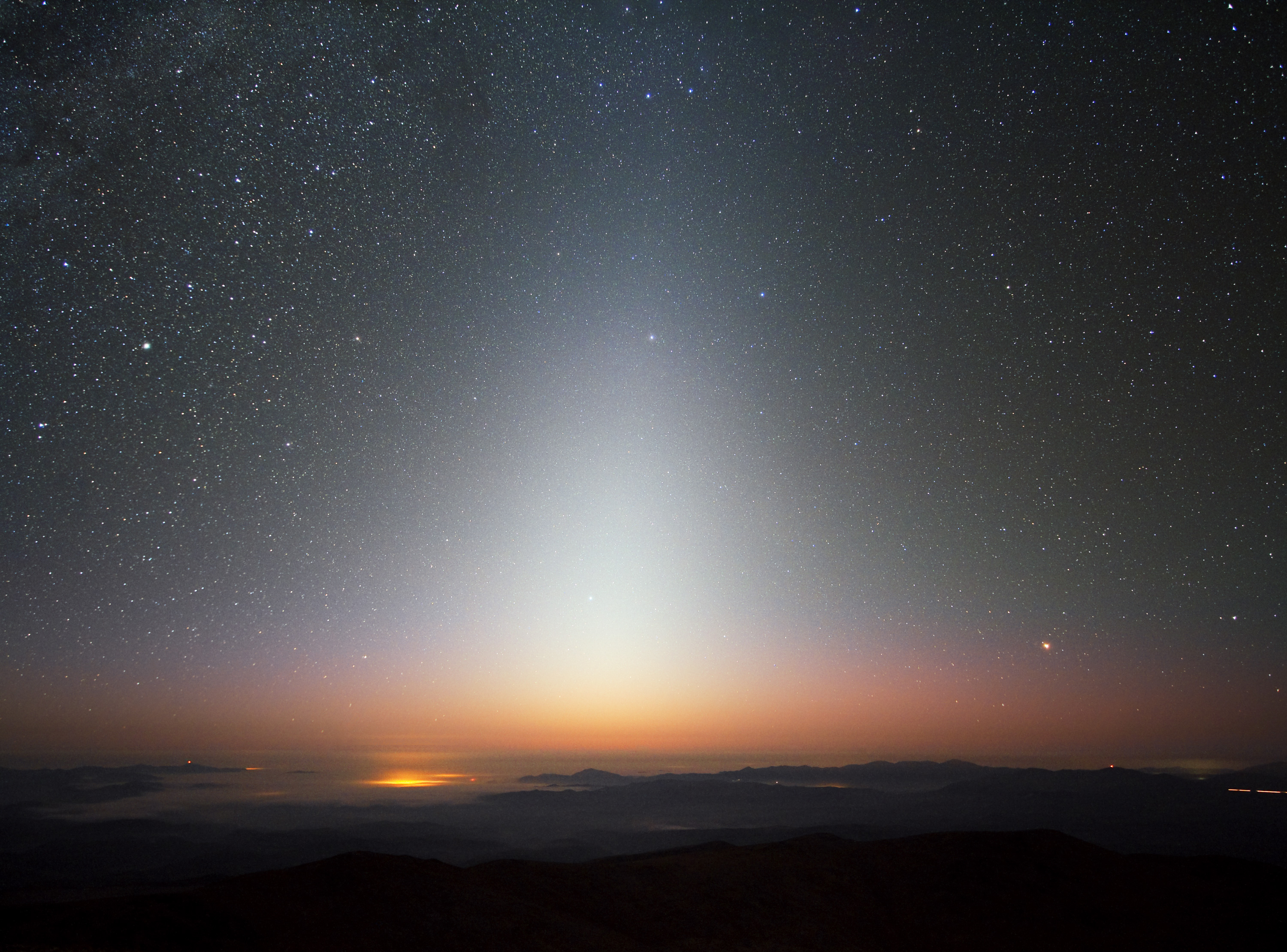
The two planets have otherwise similar atmospheres but are different colors. Neptune is a darker blue than Uranus. Why is this? According to NASA’s Jet Propulsion Laboratory, Uranus has a slightly thicker layer of haze in its upper atmosphere, which makes it whiter. If this layer did not exist, both planets would be a similar color blue. Now you know what an ice giant is and why Uranus is a different color than Neptune. On to the rest of September!
Wrapping up the general events for the month of September is the return of the zodiacal light from September 23 on for about two weeks. It will be visible as a faint glow in the mornings to the east. It’s often confused for the beginnings of sunrise but isn’t since it comes from opposite the sun, looking out into the solar system. For best visibility, find a spot with easy visibility to the horizon.
This light is formed by a cloud of dust orbiting the Sun outside the orbit of Mars. The dust is mainly sourced from asteroids impacting each other in the asteroid belt and the trails of comets.
The reason the zodiacal light’s visibility peaks in the spring is due to its orbit. The zodiac is the name for the twelve major constellations that are aligned in the apparent path of the Sun over the Earth’s orbit. This is also called the ecliptic. The angle of the ecliptic changes throughout the year, and the zodiac is best visible when the ecliptic is high in the sky. This is also when the planets are best visible since they follow the same apparent line in the sky.
I mentioned Dr. Brian May at the beginning of this segment. What does the guitarist from Queen have to do with space? Lots as it turns out. The band members first met while May was in college getting a Ph.D. in physics. The thesis he was working on concerned the zodiacal light. He left that program to be in Queen. He picked the Ph.D. back up in 2006 and was awarded his degree in 2008. His work was a genuine contribution to science since not much had been studied about the zodiacal light in the 36 years after he started the thesis.
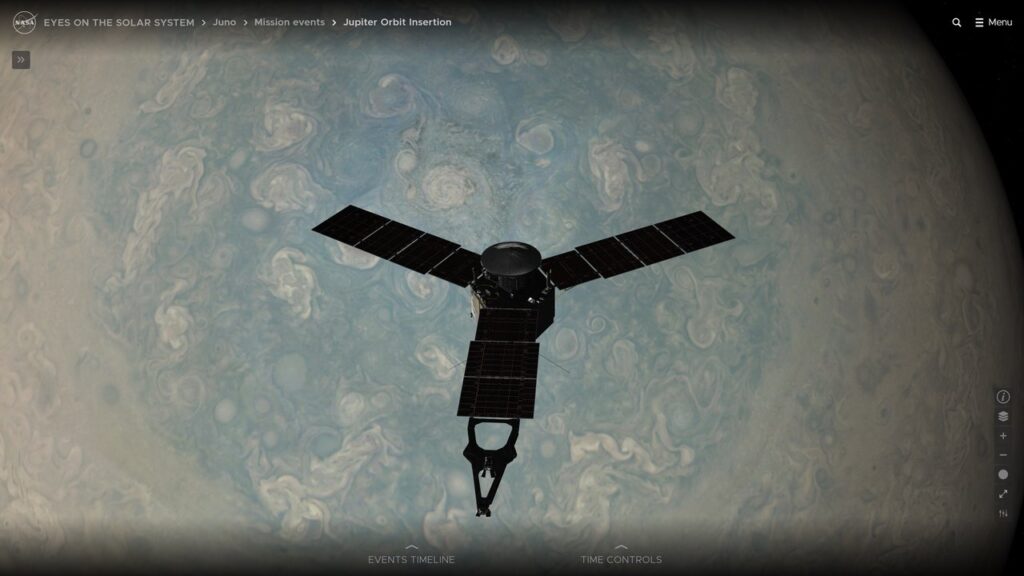
As always, go outside and look up.
And if you either cannot go outside for some reason, you can take a look around our solar system using NASA’s new-and-improved “Eyes on the Solar System” visualization tool. The latest update allows you to follow along with 126 past and present space missions, including the addition of Voyager’s Grand Tour. You can observe the paths of celestial objects between 1949 and 2049. They’ve also added Artemis 1’s trajectory… and all you need is a web browser and an internet connection. No single-use rockets required.
This has been the Daily Space.
You can find more information on all our stories, including images, at DailySpace.org. As always, we’re here thanks to the donations of people like you. If you like our content, please consider joining our Patreon at Patreon.com/CosmoQuestX.
Credits
Written by Pamela Gay, Annie Wilson, Beth Johnson, and Erik Madaus
Hosted by Pamela Gay, Beth Johnson, and Erik Madaus
Audio and Video Editing by Ally Pelphrey
Content Editing by Beth Johnson
Intro and Outro music by Kevin MacLeod, https://incompetech.com/music/


 We record most shows live, on Twitch. Follow us today to get alerts when we go live.
We record most shows live, on Twitch. Follow us today to get alerts when we go live.